Nursing Care Plan for Hypertension
NURSING CARE PLAN ON HYPERTENSION
Hypertension, commonly referred to as high blood pressure, is a medical condition where the force of blood against the walls of the arteries is consistently too high. It is often called the “silent killer” because it may not present noticeable symptoms but can lead to serious complications like heart disease, stroke, and kidney failure.
Types of Hypertension:
1. Primary (Essential) Hypertension:
Most common type, with no identifiable cause.
Develops gradually over many years.
2. Secondary Hypertension:
Caused by underlying conditions such as kidney disease, endocrine disorders, or medications.
Tends to appear suddenly and causes higher blood pressure than primary hypertension.
Risk Factors:
Non-modifiable:
Age (higher risk with advancing age)
Family history
Gender (Men are more likely to develop hypertension earlier in life)
Modifiable:
High sodium (salt) intake
Sedentary lifestyle
Obesity
Excessive alcohol consumption
Smoking
Stress
Poor diet (high in fats and low in fruits and vegetables)
Symptoms (often none, but may include):
Headaches
Dizziness
Blurred vision
Shortness of breath
Chest pain (in severe cases)
Nosebleeds (in hypertensive crises)
Complications:
Heart disease: Hypertension can lead to coronary artery disease, heart failure, and arrhythmias.
Stroke: Increased pressure can damage blood vessels, leading to blockages or ruptures in the brain.
Kidney damage: High BP can damage the blood vessels in the kidneys, leading to kidney failure.
Eye problems: Damage to the blood vessels in the retina (hypertensive retinopathy).
Aneurysm: Weakening of blood vessel walls, leading to the risk of rupture.
NURSING CARE PLAN
Nursing Diagnosis: Ineffective Health Maintenance related to lack of knowledge about disease process and lifestyle changes, as evidenced by elevated blood pressure (BP)
Subjective Data:
Patient reports occasional headaches and dizziness.
Expresses concern about high BP readings during recent visits.
Objective Data:
Blood pressure: 160/100 mmHg (elevated).
Body mass index (BMI): 30 kg/m² (overweight).
Laboratory reports show mildly elevated cholesterol levels.
Goal/Outcomes:
The patient will verbalize an understanding of hypertension and the importance of treatment within one week.
The patient will demonstrate proper BP monitoring techniques by the end of the day.
The patient will maintain a blood pressure below 140/90 mmHg in the next two months.
Nursing Interventions & Rationales:
Monitor BP regularly and record readings.
Rationale: Provides baseline data and allows for evaluation of treatment effectiveness.
Educate the patient on hypertension, its risks, and complications.
Rationale: Increasing knowledge about hypertension empowers the patient to engage in self-care and adhere to prescribed interventions.
Instruct the patient on how to correctly measure BP at home and record readings.
Rationale: Regular self-monitoring can help the patient track their BP and identify potential issues early.
Discuss the importance of lifestyle modifications (e.g., low-sodium diet, regular exercise, weight loss).
Rationale: Lifestyle changes, such as diet and exercise, play a crucial role in controlling BP and improving overall health.
Encourage the patient to engage in at least 30 minutes of moderate exercise most days of the week.
Rationale: Regular exercise helps reduce BP and promotes cardiovascular health.
Collaborate with a dietitian for meal planning to reduce sodium intake.
Rationale: Sodium restriction helps prevent fluid retention and reduces BP.
Teach the patient about the importance of medication adherence (e.g., antihypertensives, diuretics).
Rationale: Adherence to prescribed medications is essential to maintaining BP control and preventing complications.
Provide emotional support and address the patient’s concerns regarding lifestyle changes.
Rationale: Offering emotional support helps alleviate anxiety, which may affect adherence to treatment.
Evaluation:
The patient verbalizes understanding of hypertension and its management.
The patient demonstrates correct technique for home BP monitoring.
The patient reports adherence to lifestyle changes and medications, and BP readings are trending down below 140/90 mmHg.


